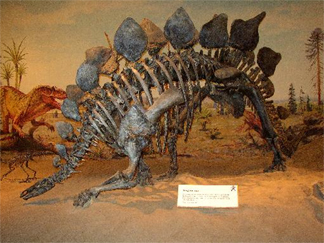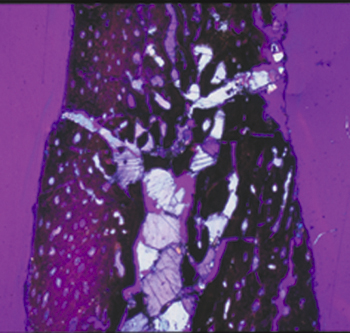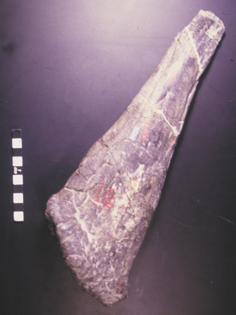Geotimes

Untitled Document

Web Extra
Friday, May 27, 2005
Style over function for stegosaur
spikes
The spikes and plates of the Jurassic Stegosaurus may look like armor
that could have staved off intrepid predators, but defense most likely was not
their main purpose. According to new research, these bony growths on the back
and tail were actually meant for species recognition — so that one Stegosaurus
could pick its friends out of a crowd.
"Paleontologists have been trying to determine what the plates and spikes
of stegosaurs were for, for over a century," says Russell Main, lead author
of a new study published in Paleobiology this month. "The hypotheses
have included defense, thermoregulation and display, either sexual or species
recognition," he says.
In previous studies, scientists ruled out the defense mechanism as the primary
function of the plates (also called scutes) and spikes, as did Main, who is
now a graduate student at Harvard University, and his co-authors. Although their
fearsome appearance may have played an accessory role in protecting the large
herbivores, the researchers determined that the relatively light construction
was not robust enough to act as a deterrent to predators, Main says. "We,
and the previous study, expected that if these structures had evolved for defense
that they would have been built more solidly," he says.
 "Just
because an animal looks like it could do something with its horns or bony dome
or plates doesn't mean it did," says Mark Goodwin from the University of
California Museum of Paleontology in Berkeley, Calif., who is not affiliated
with the study. Ornamentation in dinosaurs is fairly common and many have bony
armor, horns and spikes, he says, but that does not necessarily mean that protection
was the primary role the armor played in a dinosaur's life.
"Just
because an animal looks like it could do something with its horns or bony dome
or plates doesn't mean it did," says Mark Goodwin from the University of
California Museum of Paleontology in Berkeley, Calif., who is not affiliated
with the study. Ornamentation in dinosaurs is fairly common and many have bony
armor, horns and spikes, he says, but that does not necessarily mean that protection
was the primary role the armor played in a dinosaur's life.
In this museum display of a Stegosaurus,
the plates, or "scutes," are apparent on the dinosaur's back, although the tail
spikes cannot be seen. Image courtesy of Earth Science World Image Bank; Abi
Howe, American Geological Institute.
Another school of thought argued that the plates and spikes existed for thermoregulatory
function — to maintain a stegosaur's internal body temperature. Until now,
this has been the most widely accepted explanation, Main says, for two reasons:
The outer surface of the plates was covered in a large number of blood vessels,
and in thin section, "pipes" or open circular spaces were apparent.
If connected to the vascular network outside of the scutes, the pipes could
conduct blood to be cooled or heated by the environment. But the connection
between the two could not be determined based on a single plate that was examined
previously.
 To
find the connection between the vessels and the pipes, Main and his colleagues
studied not only the structures of stegosaurs, but also of related armored species
including their primitive ancestor, the Scutellosaurus, the younger Scelidosaurus
and the ankylosaurs, a sister group of the stegosaurs. They made thin sections
of the scutes and spikes from several specimens donated by museums.
To
find the connection between the vessels and the pipes, Main and his colleagues
studied not only the structures of stegosaurs, but also of related armored species
including their primitive ancestor, the Scutellosaurus, the younger Scelidosaurus
and the ankylosaurs, a sister group of the stegosaurs. They made thin sections
of the scutes and spikes from several specimens donated by museums.
This transverse cross section of a Stegosaurus
plate, partially crushed during fossilization due to its lightweight construction,
reveals vascular canals in the outer bone (red/purple). The inner support structure
of the plate is now filled in with a rock matrix (white). Image courtesy of
Russell P. Main.
The team thus concluded instead that the spikes and plates were for species
recognition. And the same holds true for the other groups studied, Main says.
"There was a good diversity of stegosaurs in China and also six stegosaur
taxa known from the North American Jurassic Morrison Formation," he says,
"so it seems that for stegosaurs you did have a number of different species
in the same areas, for which it would have been useful to be able to tell one
another apart."
 Several
different dinosaurs, including ceratopsians (like the Triceratops) and hadrosaurs
(duck-billed dinosaurs) show elaborate crests, horns, spikes, scutes and other
"frills." What many of them have in common, Main says, is that there
were many species of each group that all looked quite similar, apart from their
adornments. "Perhaps what our study shows best is that these bizarre structures'
purpose may be just that: to be bizarre, to differentiate one group of animals
from another," he says.
Several
different dinosaurs, including ceratopsians (like the Triceratops) and hadrosaurs
(duck-billed dinosaurs) show elaborate crests, horns, spikes, scutes and other
"frills." What many of them have in common, Main says, is that there
were many species of each group that all looked quite similar, apart from their
adornments. "Perhaps what our study shows best is that these bizarre structures'
purpose may be just that: to be bizarre, to differentiate one group of animals
from another," he says.
The tip of this Stegosaurus spike
(top right corner) broke off, either while the dinosaur was alive or during
the fossilization process. Paleontologists now think that spikes and other adornments
may have existed for species recognition. Image courtesy of Russell P. Main.
Still, the plates certainly may have played some accessory part in thermoregulation,
as well as for a defensive function, Goodwin says. Structures may have more
than one function, he says, or the function may have changed over time, during
an individual's lifespan or evolutionarily. "It's not necessarily an either/or
question," Goodwin says.
"There is evidence that both goats and reindeer can shed heat through
their horns and growing antlers, respectively," Main says, "but nobody
would argue that shedding heat is the primary purpose of these structures. We
argue the same for stegosaurs."
Laura Stafford
Back to top
Untitled Document

 "Just
because an animal looks like it could do something with its horns or bony dome
or plates doesn't mean it did," says Mark Goodwin from the University of
California Museum of Paleontology in Berkeley, Calif., who is not affiliated
with the study. Ornamentation in dinosaurs is fairly common and many have bony
armor, horns and spikes, he says, but that does not necessarily mean that protection
was the primary role the armor played in a dinosaur's life.
"Just
because an animal looks like it could do something with its horns or bony dome
or plates doesn't mean it did," says Mark Goodwin from the University of
California Museum of Paleontology in Berkeley, Calif., who is not affiliated
with the study. Ornamentation in dinosaurs is fairly common and many have bony
armor, horns and spikes, he says, but that does not necessarily mean that protection
was the primary role the armor played in a dinosaur's life.
 To
find the connection between the vessels and the pipes, Main and his colleagues
studied not only the structures of stegosaurs, but also of related armored species
including their primitive ancestor, the Scutellosaurus, the younger Scelidosaurus
and the ankylosaurs, a sister group of the stegosaurs. They made thin sections
of the scutes and spikes from several specimens donated by museums.
To
find the connection between the vessels and the pipes, Main and his colleagues
studied not only the structures of stegosaurs, but also of related armored species
including their primitive ancestor, the Scutellosaurus, the younger Scelidosaurus
and the ankylosaurs, a sister group of the stegosaurs. They made thin sections
of the scutes and spikes from several specimens donated by museums.  Several
different dinosaurs, including ceratopsians (like the Triceratops) and hadrosaurs
(duck-billed dinosaurs) show elaborate crests, horns, spikes, scutes and other
"frills." What many of them have in common, Main says, is that there
were many species of each group that all looked quite similar, apart from their
adornments. "Perhaps what our study shows best is that these bizarre structures'
purpose may be just that: to be bizarre, to differentiate one group of animals
from another," he says.
Several
different dinosaurs, including ceratopsians (like the Triceratops) and hadrosaurs
(duck-billed dinosaurs) show elaborate crests, horns, spikes, scutes and other
"frills." What many of them have in common, Main says, is that there
were many species of each group that all looked quite similar, apart from their
adornments. "Perhaps what our study shows best is that these bizarre structures'
purpose may be just that: to be bizarre, to differentiate one group of animals
from another," he says.